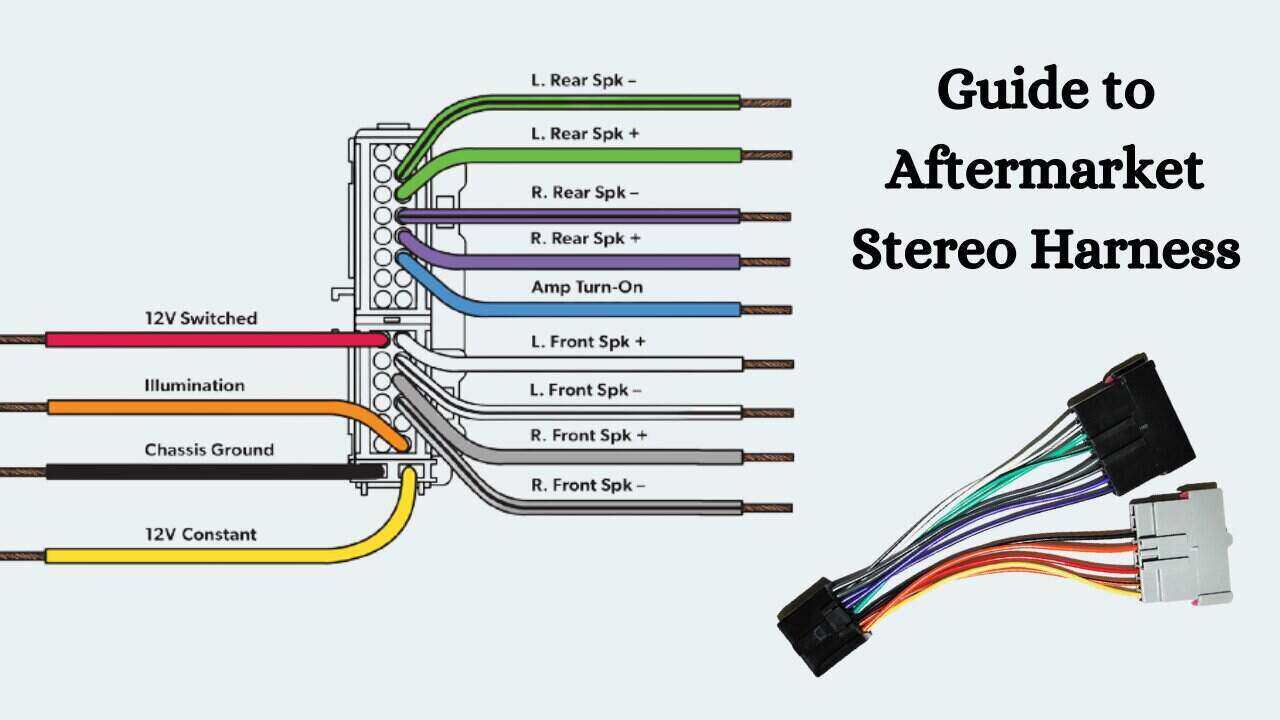Upgrading Your Car Audio? The Aftermarket Wire Harness Guide

Ever dream of crystal-clear sound in your car? Upgrading your factory car radio is a popular way to enhance your driving experience, but it’s not as simple as plugging in a new device. A critical component often overlooked is the aftermarket wire harness for car radios. This seemingly small part plays a big role in ensuring a smooth and successful audio upgrade.
So, what exactly is a car radio wiring harness adapter? It's essentially a bridge between your new stereo and your vehicle’s existing electrical system. Instead of splicing and cutting into your car's original wiring, which can be risky and time-consuming, an aftermarket harness provides a plug-and-play solution. It allows you to connect your new stereo seamlessly, saving you time and potential headaches.
The use of aftermarket harnesses became prevalent with the rise of car audio customization. In the early days of car audio, installing a new radio often involved directly manipulating the car’s wiring. This was not only complex but also increased the risk of damaging the vehicle's electrical system. The advent of the aftermarket wire harness simplified the installation process significantly, making it accessible to a wider audience.
The importance of an aftermarket harness can't be overstated. It protects your car's electrical system from damage, simplifies installation, and often retains essential factory features like steering wheel controls and warning chimes. Without the proper harness, you risk short circuits, blown fuses, and even damage to your new car stereo.
A common issue encountered with aftermarket car radio wiring is incorrect harness selection. Choosing the wrong harness can lead to compatibility problems, malfunctioning features, or even damage to your stereo and vehicle electrical system. Therefore, ensuring you have the correct harness for your specific car make, model, and year is crucial.
A car radio wire harness adapter typically consists of a series of color-coded wires, each corresponding to a specific function in both the car's electrical system and the new radio. For example, the red wire typically represents the power source, the black wire is ground, and the yellow wire is constant power for memory functions. The harness simplifies the process of matching the correct wires, eliminating the need for guesswork and minimizing the risk of errors.
One key benefit of using an aftermarket harness is the ease of installation. Instead of cutting and splicing wires, you simply connect the harness to your car’s existing wiring and then plug your new stereo into the harness. This simplifies the process dramatically, making it possible even for those without extensive electrical experience.
Another advantage is the protection it offers. Using an aftermarket car radio wiring adapter safeguards your car’s electrical system. By preventing direct modification of the original wiring, the harness minimizes the risk of short circuits and other electrical problems that could potentially damage your vehicle.
Finally, an aftermarket harness can often retain factory features. Many harnesses are designed to integrate seamlessly with your car's existing features, such as steering wheel controls, warning chimes, and OnStar systems. This allows you to enjoy the convenience of your new stereo without sacrificing important functionality.
Before starting the installation, make sure you have the correct harness for your vehicle. Consult your car's manual or an online resource to identify the appropriate harness. Once you have the correct harness, disconnect the negative terminal of your car battery. Then, carefully remove your old stereo and connect the aftermarket harness to your car’s wiring. Finally, connect the harness to your new stereo and test the connections before reinstalling everything.
Advantages and Disadvantages of Aftermarket Wire Harnesses
| Advantages | Disadvantages |
|---|---|
| Simplified Installation | Potential Incompatibility if the wrong harness is chosen |
| Protection of Car's Electrical System | Cost (though minimal) |
| Retention of Factory Features |
Five best practices for installing an aftermarket car radio wire harness: disconnect the car battery, double-check compatibility, secure connections, organize wiring for a clean look, and test functionality before finalizing the installation.
Five real-world examples: A 2005 Honda Civic owner uses a harness to retain steering wheel controls, a 2018 Ford F-150 owner upgrades to a touchscreen radio, a 1998 Toyota Camry owner simplifies installation, a 2021 Jeep Wrangler owner preserves factory amplifier integration, and a 2012 Chevrolet Silverado owner upgrades their sound system without cutting factory wires.
Frequently Asked Questions: What is an aftermarket harness? How do I choose the right harness? What are the benefits? How do I install it? What if the harness doesn’t fit? What if my steering wheel controls don't work? Can I install it myself? Where can I buy an aftermarket harness?
Tips and tricks: consult online forums, watch installation videos, check wiring diagrams, use electrical tape for secure connections, and test all functions before reassembling the dashboard.
Investing in a proper aftermarket wire harness for car radios is a crucial step in any car audio upgrade. It simplifies the installation process, protects your car's electrical system, and ensures the retention of important features. By understanding the importance of this often-overlooked component, you can ensure a smoother, safer, and more enjoyable car audio upgrade experience. Don’t underestimate the power of this small but mighty connector. It’s the key to unlocking a world of better sound in your vehicle. Make the smart choice and invest in a quality aftermarket harness for your next car audio project. You'll thank yourself later.
Harris county traffic light troubles navigating houstons intersections
Unlock your potential a guide to brian tracys maximum achievement strategies
Quench your thirst for history exploring traditional english beverages











